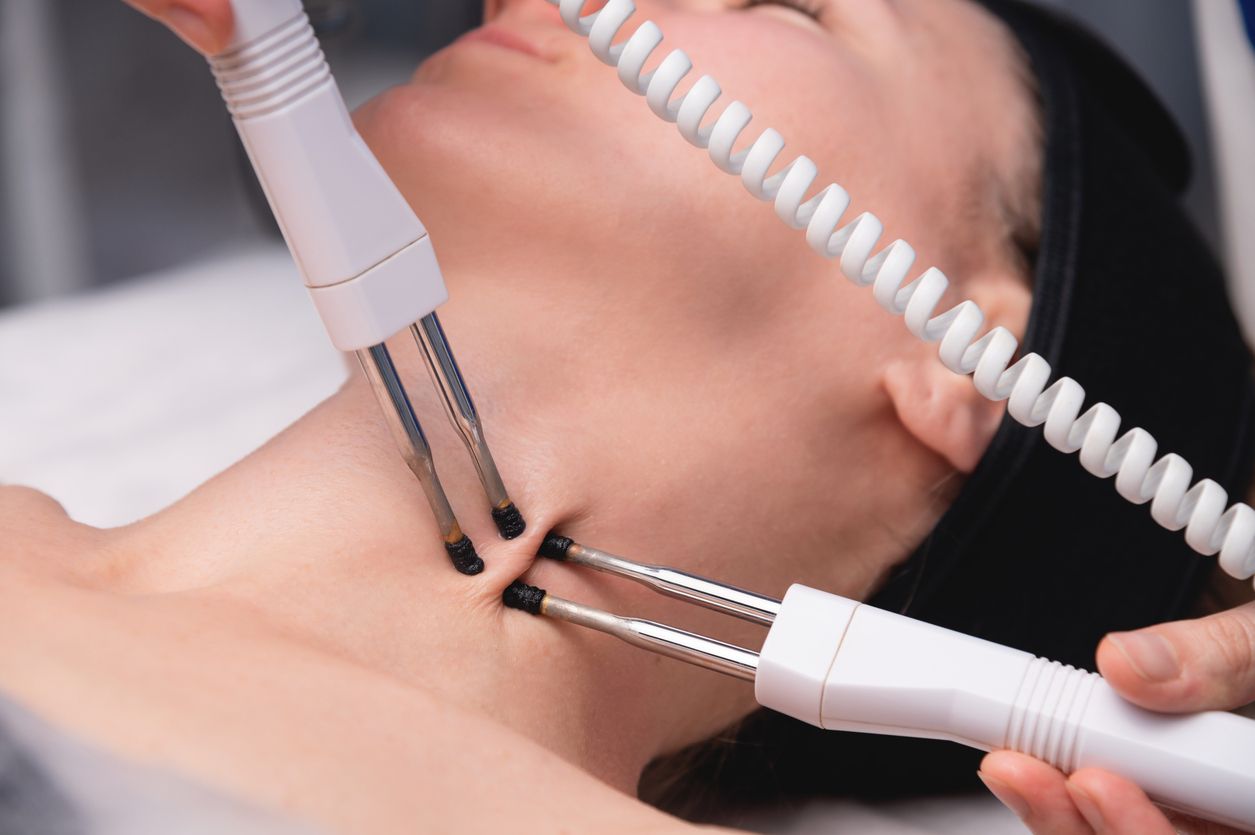- Home
- Trend
- Weight Loss Strategies
- Acne Tips
- Hair Health Information
- Blemish Removal Tips
- Acne Scar Removal Tips
- Muscle Building Techniques
- Intimate Care Tips
- Postpartum Intimate Care
- Eye Bags Wiki
- Tips for Face Slimming
- Secret of Permanent Hair Removal
- Breast Enlargement Tips
- Cure to Snoring
- Marionette Lines
- Skin-Tightening Secrets
免費體驗
S6 Body Sculpting Treatment
1 Minute Self-Registration
Date should not be before minimal date
Belly fat, also known as abdominal fat, is a common concern among many people, particularly women. It’s not just a cosmetic issue but also poses significant health risks, including heart disease, high blood pressure, and diabetes. In this article, we'll explore the causes and effects of belly fat and try to help you achieve a slimmer waistline with multiple practical tips.
The Culprits Behind Your Belly Fat Accumulation

Belly fat is more than just an aesthetic concern. Several factors contribute to its accumulation, so if you check these boxes, you are more likely to have belly fat issues:
Sedentary Lifestyle
A sedentary lifestyle is a primary culprit in belly fat accumulation. The human body is designed for movement, and when we engage in minimal physical activity, calories are more likely to be stored as fat, particularly around the midsection. Regular exercise, encompassing both cardiovascular workouts and strength training, is crucial for burning calories, building muscle mass, and preventing fat accumulation.
Dietary Choices
Consuming excessive amounts of processed foods, sugary drinks, and high-calorie snacks fuels weight gain and contributes to belly fat accumulation. These foods are often packed with unhealthy fats, refined carbohydrates, and added sugars, which can lead to insulin resistance and increased fat storage. Prioritising whole foods, lean proteins, and complex carbohydrates can help in weight management and reduce belly fat.
Hormonal Influences
Hormonal fluctuations play a significant role in fat distribution, especially in women. Conditions like menopause and polycystic ovary syndrome (PCOS) can disrupt hormone balance, leading to increased belly fat storage.
Chronic Stress
The body's stress response triggers the release of storage. Chronic stress can lead to unhealthy eating habits, sleep disturbances, and reduced physical activity, all of which contribute to weight gain and belly fat accumulation.
Lack of Sleep
Sufficient sleep is crucial for regulating hormones that control appetite and metabolism. Lack of sleep can disrupt these hormones, leading to increased hunger, cravings for unhealthy foods, and weight gain, including around the midsection.
Genetic Predisposition
While lifestyle factors play a significant role, genetics can also influence where your body tends to store fat. Some individuals may have a genetic predisposition to accumulate more fat around the midsection.
Underlying Medical Conditions
Certain medical conditions like hypothyroidism, Cushing's syndrome, and polycystic ovary syndrome (PCOS) can contribute to belly fat accumulation. It's essential to address these underlying issues to effectively reduce belly fat..
Age-Related Changes
As we age, our metabolism slows down, making it easier to gain weight, especially around the midsection. Additionally, muscle mass tends to decrease with age, further contributing to fat accumulation.
5 Key Foods Contributing to Belly Fat Accumulation

While overall dietary patterns and lifestyle factors play a significant role in belly fat accumulation, certain foods are particularly notorious for contributing to this issue. Here are five culprits:
1. Sugary Drinks
Sugary drinks such as soft drinks, sweetened teas, energy drinks, and even fruit juices are major contributors to belly fat. These beverages are high in added sugars, which can lead to excessive calorie intake without providing essential nutrients.
How They Contribute:
- Liquid Calories: Unlike solid foods, liquid calories do not trigger the same satiety signals in the brain, leading to an increased overall calorie intake.
- Insulin Resistance: High sugar intake can cause insulin resistance, leading to higher levels of circulating insulin, which promotes fat storage, particularly in the abdominal area.
- Increased Triglycerides: Excessive sugar consumption elevates triglyceride levels, which is associated with abdominal fat gain.
Recommendations: Opt for water, herbal teas, or beverages without added sugars. If you crave sweetness, consider adding fresh fruit slices to your water.
2. Processed Foods
Packaged snacks, fast food, and processed meals are often high in unhealthy fats, sodium, and added sugars. These foods are typically low in essential nutrients and high in empty calories.
How They Contribute:
- High Caloric Density: Processed foods are calorie-dense but nutrient-poor, leading to overeating without nutritional benefit.
- Inflammation: Many processed foods contain trans fats and high levels of sodium, which can lead to chronic inflammation, a condition associated with increased abdominal fat.
- Impaired Metabolism: Excessive consumption of these foods can disrupt metabolic processes, promoting fat accumulation around the abdomen.
Recommendations: Choose whole, minimally processed foods like fruits, vegetables, lean proteins, and whole grains. Prepare meals at home to better control ingredients and cooking methods.
3. Refined Grains
Refined grains, such as white bread, white rice, and pastries, lack the fibre and essential nutrients found in whole grains. Their consumption can lead to increased belly fat.
How They Contribute:
- Blood Sugar Spikes: Refined grains are rapidly broken down into glucose, causing spikes in blood sugar levels, which can result in increased fat storage in the abdominal area.
- Reduced Satiety: Low in fibre, refined grains do not provide lasting fullness, leading to overeating and additional calorie intake.
Recommendations: Opt for whole grains such as brown rice, quinoa, whole wheat bread, and oats, which provide more fibre and help regulate blood sugar levels.
4. Red Meat and Processed Meats
High consumption of red meat and processed meats like bacon, sausages, and deli meats has been linked to increased abdominal fat and other health issues.
How They Contribute:
- Saturated Fats: These meats are often high in saturated fats, which can lead to increased fat deposition around the waist.
- Preservatives and Additives: Processed meats contain preservatives and additives, such as nitrates, which can contribute to inflammation and abdominal fat accumulation.
- High Caloric Content: These meats are often calorie-dense and can lead to excessive calorie intake.
Recommendations: Limit consumption of red and processed meats and choose lean protein sources such as poultry, fish, legumes, and plant-based proteins.
5. Alcohol
Excessive alcohol consumption is a significant contributor to weight gain, especially around the midsection. A good glass of fat belly butcher gin house drink is going to cost your belly inch, as alcohol is high in empty calories and can disrupt normal metabolic processes.
How It Contribute:
- High Caloric Content: Alcoholic beverages, especially cocktails and mixed drinks, are high in calories and can contribute to overall weight gain.
- Metabolic Disruption: Alcohol can interfere with the body’s ability to burn fat, slowing down metabolism and promoting fat storage, particularly in the abdominal area.
- Increased Appetite: Alcohol can increase appetite and lead to poor food choices, further exacerbating weight gain.
Recommendations: Moderate alcohol consumption and choose lower-calorie options when you drink. Limit intake to avoid contributing excess calories and disrupting your metabolism.
The Perils of Belly Fat: Health Risks Abound
Excess belly fat poses a significant threat to your overall health, as it is closely linked to various chronic diseases. Research has consistently highlighted how this type of fat, particularly visceral fat, can impact different aspects of health:
- Cardiovascular Disease: The presence of excess belly fat, especially visceral fat, is strongly associated with an increased risk of cardiovascular conditions such as heart disease and stroke. This type of fat releases inflammatory substances that can damage the lining of blood vessels. Over time, this inflammation contributes to the buildup of plaque in the arteries, which can lead to atherosclerosis—a major risk factor for heart attacks and strokes.
- Type 2 Diabetes: Visceral fat plays a crucial role in the development of insulin resistance, a condition where the body's cells become less responsive to insulin. Insulin is a hormone that helps regulate blood sugar levels. When the body’s cells do not respond effectively to insulin, it results in elevated blood sugar levels, leading to type 2 diabetes. This chronic condition can have serious complications, including nerve damage, kidney disease, and vision problems.
- High Blood Pressure: Obesity, particularly when fat accumulates around the midsection, is a significant risk factor for hypertension (high blood pressure). The additional weight puts extra strain on the heart and blood vessels, which can lead to increased blood pressure. Chronic high blood pressure can further contribute to cardiovascular disease and other health issues, such as kidney disease and stroke.
- Sleep Apnea: Excess belly fat can contribute to obstructive sleep apnea, a disorder where the airway becomes blocked during sleep, causing pauses in breathing. This condition often leads to disrupted sleep, fatigue, and can increase the risk of other health problems such as heart disease and high blood pressure.
- Certain Types of Cancer: Emerging studies suggest a correlation between excess belly fat and an increased risk of several types of cancer, including colon, breast, and endometrial cancer. The mechanisms behind this association are not fully understood, but it is thought that the inflammatory substances released by visceral fat may play a role in cancer development.
- Liver Disease: Non-alcoholic fatty liver disease (NAFLD) is commonly associated with obesity, particularly when excess fat accumulates in the abdominal area. NAFLD occurs when fat builds up in the liver without a clear cause such as excessive alcohol consumption. If left untreated, it can progress to more severe liver conditions, such as non-alcoholic steatohepatitis (NASH) and liver cirrhosis.
5 Effective Solutions for Reducing Belly Fat

If you are getting worried and would like to have a flatter midsection, here are some strategies to consider:
1. Harness the Power of Functional Foods
Incorporating foods rich in probiotics and omega-3 fatty acids can support gut health and potentially aid in weight management. Probiotics, found in yoghurt, kefir, and sauerkraut, contribute to a healthy gut microbiome, which has been linked to reduced belly fat.
Omega-3 fatty acids, abundant in fatty fish, flaxseeds, and walnuts, possess anti-inflammatory properties that can help combat inflammation associated with belly fat.
2. Prioritise Protein and Fiber
Protein plays a crucial role in satiety and muscle building. Opt for lean protein sources like chicken, fish, beans, and tofu. Fibre-rich foods such as whole grains, fruits, and vegetables help regulate digestion and prevent blood sugar spikes, reducing the likelihood of fat storage.
3. Master Your Metabolism with Exercise
Regular physical activity is essential for burning calories and building muscle mass. A combination of cardiovascular exercise (like running, swimming, cycling or even some belly training sessions at home), and strength training is ideal. Aim for at least 150 minutes of moderate-intensity exercise or 75 minutes of vigorous-intensity exercise per week.
4. Optimise Sleep for Weight Management
Sufficient sleep is often overlooked but plays a vital role in weight control. Lack of sleep disrupts hormones that regulate appetite and metabolism, leading to increased cravings and weight gain. Aim for 7-9 hours of quality sleep per night.
5. Manage Stress for a Slimmer Waistline
Chronic stress can contribute to belly fat accumulation by triggering the release of cortisol, a hormone linked to fat storage. Incorporate stress-management techniques like meditation, yoga, or deep breathing into your daily routine.
免費體驗
S6 Body Sculpting Treatment
1 Minute Self-Registration
Date should not be before minimal date
The 6th Solution: S6 Body Sculpting Treatment
Aside from trying those strategies, Perfect Medical introduces the S6 Body Sculpting Treatment, a cutting-edge solution designed to target and reduce stubborn fat deposits. This non-invasive procedure combines advanced bio-laser technology with vacuum suction for optimal results.
The S6 treatment employs high-functioning bio-lasers to penetrate the skin and induce fat cell breakdown. The released fatty acids are then efficiently removed from the body through lymphatic drainage facilitated by vacuum suction technology. This innovative approach effectively diminishes fat cells without surgical intervention, pain, or downtime.
The S6 treatment is particularly effective in targeting those stubborn fat areas that often resist diet and exercise, such as the waist, abdomen, arms, thighs, calves, and hips. Notably, the treatment is designed to destroy fat cells, preventing them from regenerating and ensuring longer-lasting results.
Perfect Medical's commitment to personalised care is evident in their approach. Each client undergoes a thorough body assessment to tailor the treatment plan accordingly. The procedure is comfortable and designed to deliver noticeable improvements after the first session.
By choosing the S6 Body Sculpting Treatment, you can enjoy a slimmer, more sculpted physique especially with your abdominal area, without the need for invasive procedures or extended recovery periods.
Get Rid of That Fat Belly & Regain Good Body Composition
Belly fat is not just a cosmetic concern but a significant health risk. While lifestyle changes like a balanced diet and regular exercise are crucial, sometimes they are not enough to tackle stubborn fat. Perfect Medical’s S6 Body Sculpting Treatment offers an advanced, non-invasive solution to help you achieve a slimmer, healthier body. With its combination of bio-lasers and vacuum suction technology, you can target and reduce belly fat effectively and safely.
For more information on the S6 Body Sculpting Treatment, you can click on the link below to book your trial session. Our professional team is ready to help you achieve your weight loss goals and improve your overall health!
免費體驗
S6 Body Sculpting Treatment
1 Minute Self-Registration
Date should not be before minimal date
FAQ

1. How can researchers' findings help in reducing belly fat?
Researchers have found that reducing belly fat involves a combination of a healthy diet, regular exercise, and lifestyle changes. Engaging in aerobic activities, strength training, and high-intensity interval training (HIIT) can effectively target belly fat. Monitoring caloric intake and avoiding high-sugar foods are also crucial steps.
2. How can a bathroom scale with body fat percentage measurement aid in managing body fat?
A bathroom scale that measures body fat percentage provides a more comprehensive view of an individual's health than weight alone. It helps track changes in body composition, allowing users to see reductions in fat and increases in lean tissue. This data can be motivating and informative, helping individuals adjust their diet and exercise routines for better results.
3. What role does a health care provider play in addressing excess body fat?
A health care provider can offer personalised advice and plans to reduce excess body fat. They can recommend specific exercises, dietary adjustments, and lifestyle changes tailored to an individual's health status and goals. Regular check-ins with a health care provider can ensure progress is on track and adjustments are made as needed.
4. Are there apps available that can assist in monitoring and reducing belly fat?
Yes, there are many apps designed to help monitor and reduce belly fat. These apps often sync with bathroom scales and fitness trackers to provide real-time data on body fat percentage and overall progress. They offer workout plans, dietary tips, and tracking features to keep users motivated and informed about their health journey.
5. What are some effective ways to target and reduce belly fat specifically?
Effective ways to reduce belly fat include engaging in regular physical activity, such as aerobic exercises, strength training, and HIIT. A balanced diet that focuses on whole foods, reduced sugar intake, and controlled portion sizes is crucial. Additionally, managing stress, getting adequate sleep, and staying hydrated are essential factors in reducing belly fat.








